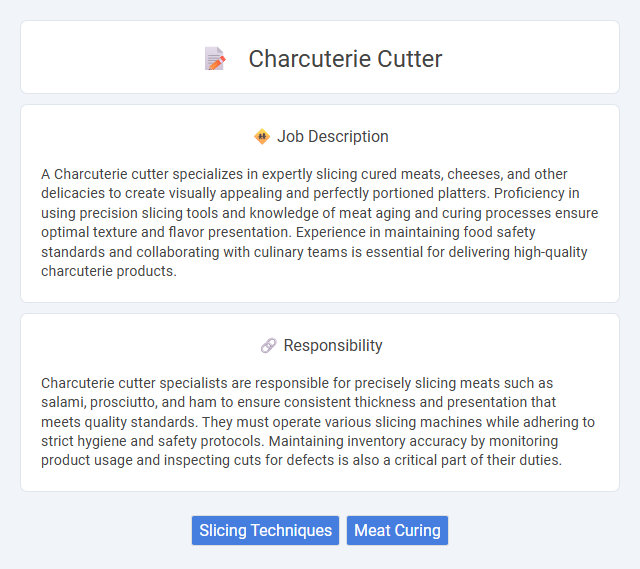
A Charcuterie cutter specializes in expertly slicing cured meats, cheeses, and other delicacies to create visually appealing and perfectly portioned platters. Proficiency in using precision slicing tools and knowledge of meat aging and curing processes ensure optimal texture and flavor presentation. Experience in maintaining food safety standards and collaborating with culinary teams is essential for delivering high-quality charcuterie products.
Individuals with strong hand-eye coordination and the ability to maintain focus for extended periods are likely suitable for a charcuterie cutter position. Those who prefer repetitive tasks in a controlled environment might find this job well-suited to their skills. Candidates with physical stamina and good manual dexterity could have a higher probability of success in this role.
Qualification
A Charcuterie cutter must possess extensive knowledge of meat types, cuts, and curing processes, ensuring precise slicing and presentation of cured meats and sausages. Proficiency with specialized cutting tools and adherence to food safety standards and hygiene regulations are essential qualifications. Prior experience in a deli, butcher shop, or charcuterie production setting enhances the ability to deliver high-quality and visually appealing products.
Responsibility
Charcuterie cutter specialists are responsible for precisely slicing meats such as salami, prosciutto, and ham to ensure consistent thickness and presentation that meets quality standards. They must operate various slicing machines while adhering to strict hygiene and safety protocols. Maintaining inventory accuracy by monitoring product usage and inspecting cuts for defects is also a critical part of their duties.
Benefit
Working as a charcuterie cutter likely offers benefits such as skill development in precision slicing and knowledge of various cured meats, which can enhance culinary expertise. There is a probable opportunity for increased job satisfaction through the artistry involved in creating visually appealing meat and cheese boards. This role may also provide steady employment in specialty food markets or artisanal shops, contributing to a stable income.
Challenge
The charcuterie cutter job likely presents challenges related to maintaining precision and consistency when slicing various cured meats, which may demand steady hands and sharp attention to detail. There is probable pressure to meet high production standards while minimizing waste, requiring strong time management skills. Handling equipment safely and ensuring food hygiene protocols could also pose ongoing difficulties in this role.
Career Advancement
A Charcuterie Cutter specializing in precision slicing and meat preparation can advance into supervisory roles or quality control positions within food production companies. Gaining expertise in various meat cuts and mastering sanitation standards often leads to opportunities in management or specialized culinary roles. Continuous skill development and certifications in food safety can significantly enhance career growth and job stability in the meat processing industry.
Key Terms
Slicing Techniques
Expertise in slicing techniques is crucial for a Charcuterie cutter, ensuring uniform thickness and precision when preparing various meats such as prosciutto, salami, and coppa. Mastery of manual and mechanical slicing tools enhances efficiency and maintains the integrity of delicate cured meats, preserving texture and flavor. Knowledge of grain direction and proper knife angles prevents product damage, optimizing presentation and customer satisfaction.
Meat Curing
Charcuterie cutters specialize in precise slicing and portioning of cured meats such as prosciutto, salami, and pancetta, ensuring optimal texture and flavor presentation. Their expertise in meat curing techniques, including aging, salting, and smoking, is essential to develop complex flavor profiles and preserve product quality. Mastery of hygiene standards and temperature control during the curing process prevents spoilage and guarantees food safety.
 kuljobs.com
kuljobs.com